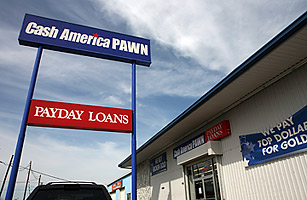
With banks reluctant to loosen purse strings and credit-card companies aggressively slashing credit lines, a growing number of consumers are turning to the once murky world of pawnshops for quick cash. “Loans are up 20% to 25%,” estimates David Crume, president of the National Pawnbrokers Association.
The trade group’s executive director, Dana Meineke, says the weak economy and turmoil in the credit markets are expanding the customer base. “We’re seeing some new faces,” says Daniel Feehan, president and chief executive of Cash America International, a pawnshop company based in Fort Worth, Texas.
Severe unemployment certainly boosts business for pawnshops, but so too does the high price of gold. The precious metal’s price is up to more than $1,200 an ounce, vs. about $860 in January 2009. Suddenly, dusting off that old flame’s gold necklace is an easy way to score a quick loan. “With the price of gold moving higher, it allows individuals to get a bigger loan, and that has been a stimulus to driving increased pawn lending,” says Joshua Elving, a senior analyst at Feltl & Co.
Pawnshop companies make money by giving short-term loans to customers who offer jewelry, electronics, tools, musical instruments and other merchandise as collateral or by purchasing merchandise outright from customers at a steep discount. Loan terms are typically one to three months in length, with customers expected to cough up monthly storage and loan-servicing fees of 10% to 20% a month. If a customer fails to make a monthly payment, the pawnshop, following a grace period, can sell the item.
Although pawn loans are far pricier than credit-card and bank loans, they also are faster, don’t require complicated paperwork and don’t affect one’s personal credit. Since the loan is backed by merchandise, if the loan isn’t repaid, the person simply loses the pawned item — “whereas with other types of loans, I could lose my house or car,” says Henry Coffey, a senior analyst at Sterne Agee & Leach.
“Gold is an important input because most pawnshops make most of their money on jewelry,” notes John Rowan, an analyst at Sidoti & Co. He says the three publicly traded pawnshop companies — Cash America International, EZCorp and First Cash Financial Services — generated earnings that outperformed many other companies in the financial-services sector over the past year and a half. “They didn’t crater like other industries did throughout the recession,” says Rowan.
First Cash Financial recently raised earnings guidance for fiscal 2009 and 2010 to reflect higher than expected revenue from the company’s pawnshop operations in the U.S. and Mexico. “Our fourth-quarter pawn revenues significantly exceeded our expectations,” said Rick Wessel, the company’s chief executive, in a statement. The revised projections imply earnings growth of 20% to 26% for the fourth quarter, up to 14% for fiscal 2009 and as much as 16% in fiscal 2010.
The company’s rivals are on track to post even bigger gains: Cash America and EZCorp are currently projecting earnings growth of up to 20% in fiscal 2010. The three companies’ stocks improved in 2009 — Cash America climbed 28%, First Cash rose 16% and EZCorp was up 13% — and analysts expect the rally to continue this year. “You’ve got cheap stocks growing at 20% a year,” says Coffey, “so the stage is set for a pretty good 2010.”
Still, pawnshops have not been unscathed in the recession. With Americans cutting back on spending, many are requesting smaller loans, and others are spending less money buying items from pawnshops. This is expected to turn around as the economy starts to recover.
The bigger obstacle for pawnshop owners is legislation. The three public pawnshop companies also make so-called payday loans: short-term loans, typically seven to 30 days in length, that are not backed by merchandise. The loans typically carry interest rates of 10% to 20% for a two-week term, which translates into an annual percentage rate exceeding 300%. Industry experts say the APR is just theoretical since payday loans are meant to be very short term, lasting only until the borrower’s next paycheck. Even so, a number of states, like Ohio, are imposing caps on the rates in an effort to stop what they consider to be predatory lending.
The restrictions made it difficult for lenders to turn a profit, causing many to shut down their payday-loan programs in those states. “Payday lenders are lending unsecured money to individuals with no credit history and no credit score,” says Elving. “So it’s truly a situation where they have to price for risk.”
Coffey estimates that payday loans account for 35% of Cash America’s revenue, 22% of EZCorp’s total revenue and only 10% to 12% of First Cash’s revenue. First Cash recently sold all 22 of its payday outlets in California, Washington and Oregon to lower its exposure to payday-loan regulatory issues — a move Elving says should boost the company’s valuation.
When politicians began discussing similar restrictions at the federal level, nervous investors sold off the pawnshop stocks. When the most restrictive proposal — a 36% cap proposed by Senator Richard Durbin, a Democrat from Illinois — failed to win support, the shares rebounded. However, the Senator has reintroduced the bill in the current session of Congress, and it could ultimately find its way into financial-industry reform. More worrisome to investors is the potential power of a Consumer Financial Protection Agency, part of the financial-reform bill recently passed by the House and under consideration in the Senate. Under the current versions of the bill, the agency would not have the power to set interest rates. But public anger with America’s financial industry is rising, and that raises the possibility that extremely high interest-rate charges could ultimately be subject to federal limits.
See the top 10 everything of 2009.
See the top 10 pictures of 2009.